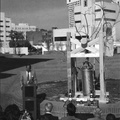ONE AUGUST MORNING, time allowed for me to view Killer Subs at Pearl Harbor, a DVD about the five Japanese mini-submarines, called “tubes” while being produced at Kure Naval Base in Hiroshima. To remain submerged for a long time, air conditioners were installed for the two-man minisubs. Torpedoes were trimmed to fit. Gyrocompass provided direction while undersea.
By late November, 1941, minisubs were transported by a mother sub for Hawaii. Their mission was not to fire until after the air attack. That their orders were personally handed from the Japanese Sixth Fleet admiral only heighten the glory to come.
The DVD mentions each minisub by number that entered Honolulu harbor but not No.3.—it struck a reef miles away from Pearl Harbor and sank. For details, I lowered Gordon Pranges’ At Dawn We Slept: the Untold Story of Pearl Harbor (1981) from our library case and sat glued to Chapter 58, “This Means War.”
Aboard the first class sub I-24, Ensign Kazuo Sakamaki peered through the periscope at the green and red lights blinking from Pearl Harbor. His minisub gyrocompass had been out of order and efforts to fix were fruitless. Nonetheless, Sakamaki’s and his crewman Kiyoshi Inagaki’s enthusiasm were fired, shouting “On to Pearl Harbor.” (Prange, 480).
The next book, Ulrich Straus’s, The Anguish of Surrender: Japanese POWs of World War II, (2003, 282pp) focusing on Sakamaki as U.S. Prisoner of War No. 1 is the grist for this column. A graduate of the naval academy at Etajima who had met Admiral Isoroku Yamamoto, Commander-in-Chief of the Combined Fleet on his flagship in October, 1941, minsub crews were told they were about “to engage in an operation offering far greater glory than much more senior officers in the surface navy could hope to win.”
Life at Etajima was rigorous, physically and mentally. It left no room for individual thinking, instead the need for absolute obedience to military superior. There was no middle ground between victory and defeat. He came to believe it was “critical for us to die manfully on the battlefield.”
At age 21, Sakamaki’s mind was set to sink the battleship Pennsylvania with his two torpedoes—but bad luck dogged his mission. When his minisub was launched with a malfunctioning gyrocompass, he never found the entrance to Pearl Harbor.
As the minisub careened undersea toward Diamond Head, his grim determination to sink the Pennsylvania (which he didn’t know was still in dry dock) remained, and with no idea where he was, the minisub eventually hit a reef near Kaneohe and began to sink. Impact split the minisub in two, and threw him into the water. His companion perished.
Ensign Sakamaki swam 500 yards to shore and was arrested at dawn Monday (Dec. 8, 1941) by Sgt, David Akui and Roy Terada, two Territorial Guards on patrol, who had witnessed the bombing at Pearl on Sunday. The damaged minisub was spotted, brought ashore for study. Sakamaki was imprisoned at Camp McCoy, Wisconsin.
In accordance with the Geneva Convention, the United States notified Japan through the international committee of the Red Cross that Sakamaki was taken captive. The Japanese navy was in a quandary; death notices were not made public, but a prisoner was listed as “attached to Yokosuka Navy Yard”. During his first eight weeks in Hawaii, he was constantly interrrogated by Lt. Gero Iwai and Lt. Cmdr. Douglas Wada, two Nisei in the Navy prewar.
Only thing Sakamaki knew was that he was a total failure; worse, his submarine fell into enemy hands and he suffered the ultimate shame of becoming a prisoner of war. Unprepared psychologically, utterly on his own, no one to come and help, he fell into deep depression with thoughts of suicide. Even more important, he felt he was besmirching his own family.
Following Japan’s surrender, Sakamaki was returned to his war-ravaged homeland, debriefed by Japanese naval officers now compiling a history of prisoners of war and was told not to feel ashamed nor worry about his POW status.
Called as a prosecution witness at the International Military Tribunal for the Far East, he testified Allies’ treatment of Japanese POWs was good and in books and interviews years later appreciated how humane their approach was. He participated at a symposium on POWs in Austin, Texas, where he finally saw his minisub at the Nimitz War Museum..
Approached by American press to comment at the 50th anniversary of Pearl Harbor, he declined. Near the end of his life when asked to comment on how Japan developed postwar, Sakamaki believed Japan was still somewhat feudal and needed to grow and adjust to the globalized world. He died on Nov. 29, 1999. At the family’s request, the funeral was private.
In conclusion Straus compares the treatment of prisoners of war by the Allies and by the Japanese. The difference could not be greater. Allied prisoners encountered brutality, death and extreme working conditions and made no pretense of living up to the Geneva Convention, although Japan’s foreign minister indicated at the outset of war they might do so.
* * *
Born in Germany, Ulrich’s family moved to Tokyo for business reasons. He grew up in Tokyo (1933-1940), fled to America in late 1940, and recruited in 1944 to attend the Army language school at the Univ. of Michigan. Because he knew both German and Japanese, “Rick” was placed in the translation section at GHQ during the Occupation (1946-1951), participated at the trial of Japan’s major war criminals, entered the U.S. Foreign Service (1952), served as U.S. consul general in Okinawa (1978-1982) and retired in 1987 to write. The remaining ten chapters can be an eye-opener for a lot of us Nisei veterans, infantry or intelligence.
© 2011 Harry Honda






